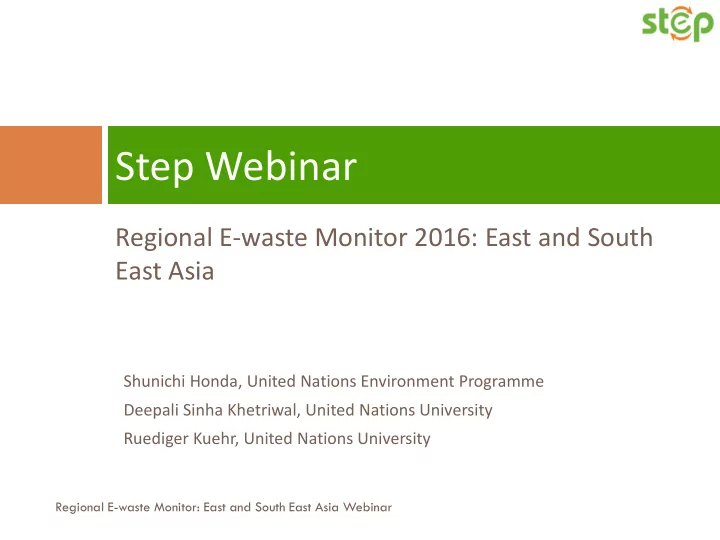

Step Webinar Regional E-waste Monitor 2016: East and South East Asia Shunichi Honda, United Nations Environment Programme Deepali Sinha Khetriwal, United Nations University Ruediger Kuehr, United Nations University Regional E-waste Monitor: East and South East Asia Webinar
The First Regional Monitor A Comprehensive Study on E-waste in East and Southeast Asia Identification of E- waste management status Comparison among different approach for E-waste management http://ewastemonitor.info/ Regional E-waste Monitor: East and South East Asia Webinar
Why East and South Asia? Large & growing population Increasing per capita incomes Regional E-waste Monitor: East and South East Asia Webinar
Past Projects on E-waste in the East and Southeast Asian Basel Convention Partnership on the Environmentally Sound Management of E-waste for Asia-Pacific Region Asian Network for Prevention of Illegal Transboundary Movement of Hazardous Wastes Desk Study on the environmentally sound management of hazardous wastes including E-waste in Asia Environmentally sound technologies for E- waste management International E-waste Management Network Annual workshop on E-waste management Regional E-waste Monitor: East and South East Asia Webinar
Overview of E-waste Management in East & Southeast Asia Regional E-waste Monitor: East and South East Asia Webinar
Quantification and Assessment Methodologies Inventory Method 1: Country Assessments under the Asia E-waste Project Method 2: National E-waste Inventories under UNU Projects Method 3: National E-waste Inventories under Other Projects Transboundary Shipments the Basel Convention national reporting data Regional E-waste Monitor: East and South East Asia Webinar
E-waste Arising Large volume of e-waste generated Increasing per capita e-waste generated Large differences between countries Regional E-waste Monitor: East and South East Asia Webinar
E-waste Arising Regional E-waste Monitor: East and South East Asia Webinar
Current status of E-waste management E-waste legislation National legislation with Extend Producer Responsibility E-waste collection, treatment and recycling Collection: by retailers, collection points in municipalities, 1. by informal collectors; Dismantling and depollution: Manual process 2. Sorting and separation: Manual or mechanical means 3. Material and energy recovery: Secondary material and 4. energy source Regional E-waste Monitor: East and South East Asia Webinar
Common issues and challenges Increasing volumes Improper and illegal dumping Open burring Backyard acid baths Occupational and community health Competition between informal and formal sectors Transboundary movements Regulation and enforcement System financing Regional E-waste Monitor: East and South East Asia Webinar
E-waste management system matrix and types Type 1 Advance mechanism Strong legal framework for e-waste Established and functional collection and recycling infrastructure High environmental health and safety standards. Type 2 Voluntary initiative Private sector initiative, including take-back programme E-waste management in the absence of a legal framework for e-waste Type 3 In transition Nascent legal framework that is still being tested Collection and processing infrastructure involving a mix of formal and informal actors, Type 4 Informal initiative Informal sector for collection, recycling and disposal of e-waste No established legal framework Regional E-waste Monitor: East and South East Asia Webinar
E-waste Management Status Regional E-waste Monitor: East and South East Asia Webinar
Type 1 Advanced Mechanism Japan, Taiwan and South Korea Population GDP per E-waste per E-waste management (million) capita (USD) capita (kg) Japan 127 38,142 17.3 Home Appliance Recycling Law, Law for Recycling of Small Electronic Appliances, etc Taiwan 23 22,002 18.6 4-in-1 Recycling Program, Recycling Management Fund South 49 28,739 15.9 Act on the Resource Circulation of Electrical and Korea Electronic Equipment and Vehicles 2.500.000 2.000.000 tonnes 1.500.000 1.000.000 500.000 0 2009 2010 2011 2012 2013 2014 2015 2016 Japan-Big 6 South Korea - Big 6 Taiwan- Big 6 Japan - Total South Korea - Total Taiwan - Total
Type 2 Voluntary Initiative Singapore, Hong Kong Population GDP per E-waste per E-waste management (million) capita (USD) capita (kg) Singapore 5.4 55,568 19.5 Voluntary partnership (REcycling Nations Electronic Waste, Project Homecoming, etc) Hong Kong 7.1 40,175 21.7 Voluntary programs (WEEE Recycling Program, the Computer Recycling Program, etc) 180.000 160.000 140.000 120.000 tonnes 100.000 80.000 60.000 40.000 20.000 0 2009 2010 2011 2012 2013 2014 2015 2016 Singapore-Big 6 Hong Kong - Big 6 Singapore - Total Hong Kong - Total
Type 3 In transition China, Malaysia, the Philippines and Vietnam Population GDP per E-waste per E-waste management (million) capita (USD) capita (kg) China 1,300 7,333 4.4 Channelization of e-waste to formal sector Malaysia 29.62 10,000 7.8 E-waste as part of hazardous waste under the law Philippines 107 2,935 1.3 Informal/secondhand markets Vietnam 92.5 2,073 1.3 Take back of EOL electronics pursuant to a newly adopted decision 8.000.000 7.000.000 6.000.000 tonnes 5.000.000 4.000.000 3.000.000 2.000.000 1.000.000 0 2009 2010 2011 2012 2013 2014 2015 2016 China -Big 6 Malaysia - Big 6 Philippines - Big 6 Vietnam - Big 6 China - Total Malaysia - Total Philippines - Total Vietnam - Total
Type 4 Informal Initiative Cambodia, Indonesia and Thailand with Type 2 Population GDP per E-waste per E-waste management (million) capita (USD) capita (kg) Cambodia 15.2 1,108 1.1 Informal sector Indonesia 251 3,404 2.9 Informal sector and some voluntary programes by international producers Thailand 68.5 5,450 6.1 Informal sector and some formal sectors 1.000.000 900.000 800.000 700.000 tonnes 600.000 500.000 400.000 300.000 200.000 100.000 0 2009 2010 2011 2012 2013 2014 2015 2016 Cambodia -Big 6 Indonesia - Big 6 Thailand - Big 6 Cambodia - Total Indonesia - Total Thailand - Total
Findings E-waste in East and Southeast Asia jumps 63% in 5 Years (12.3 million tonnes in 2015) Lack infrastructure for environmentally sound e-waste management, but the increasing volumes are a cause for concern Common practices such as open burning, which can cause acute and chronic ill-effects on public health and the environment Needs of a holistic approach to waste management, taking into account many factors, such as a country’s socio-economic development, governance structures environmental awareness and health and safety standards, etc. Regional E-waste Monitor: East and South East Asia Webinar
Thank you! Regional E-waste Monitor: East and South East Asia Webinar
Recommend
More recommend